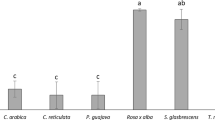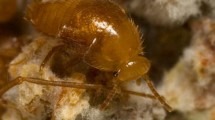Abstract
Chemical-based mimicry and camouflage are known to be employed by invertebrate parasites of social insect colonies, but the use of this strategy by vertebrates to avoid being detected by social insects has received less attention. In this paper, we examine the hypothesis that frog Lithodytes lineatus has skin chemicals that imitate chemical recognition used by leaf-cutting ants of genus Atta. We show that individuals of Lithodytes lineatus were never attacked by the leaf-cutting ants of genus Atta, while 100 % of four other anuran species were. In addition, none of the ten individuals of frog Rhinella major coated with skin extracts of frog L. lineatus were attacked, whereas controls (coated with ultrapure water) were attacked on each occasion. Our results demonstrate that the skin of frog Lithodytes lineatus has chemicals that prevent the attack of both species of leaf-cutting ants, Atta laevigata and Atta sexdens.
Significance statement
In order to reduce the risk of predation, some frog species engage in commensal or mutualistic relationships with invertebrates, but associations between frogs and ants are rarely reported in literature. We show that frog Lithodytes lineatus are not attacked by ants Atta laevigata and A. sexdens; however, other frog species are aggressively attacked. Our results suggest that the biomolecules present in the frog skin are capable of inhibiting the attack of ants, allowing coexistence. This is the first study reporting the possible mechanism for association between frog L. lineatus and ants of genus Atta.




Similar content being viewed by others
References
Cocroft RB, Hambler K (1989) Observations on a commensal relationship of the microhylid frog Chiasmocleis ventrimaculata and the burrowing theraphosid spider Xenesthis immanis in Southeastern Peru. Biotropica 21
Daly JW, Myers CW, Whittaker N (1987) Further classification of skin alkaloids from neotropical poison frogs (Dendrobatidae), with a general survey of toxic/noxious substances in the amphibia. Toxicon 25:1023–1095
De Sá RO, Grant T, Camargo A, Heyer WR, Ponssa ML, Stanley E (2014) Systematics of the neotropical genus Leptodactylus Fitzinger, 1826 (Anura: Leptodactylidae): phylogeny, the relevance of non-molecular evidence, and species accounts. South Am. J Herpetol 9:S1–S128
Déjean A, Amiet JL (1992) Un cas de myrmécophilie inattendu: la cohabitation de l’anoure Kassina senegalensis avec la fourmi Megaponera foetens. Alytes 10:31–36
Della Lucia TMC (2011) Formigas – cortadeiras: da Bioecologia ao Manejo. Editora UFV, Brasil
Dundee HA (1999) Gastrophryne olivacea (Great Plains Narrowmouth Toad). Aggregation with tarantula. Herpetol Rev 30
Dundee HA, Shilligton C, Yary CM (2012) Interactions between tarantulas (Aphonopelma hentzi) and narrow-mouthed toads (Gastrophyrne olivacea): support for a symbiotic relationship. Tulane Stud Zool Bot 32:31–38
Grant T, Frost DR, Caldwell JP, Gagliardo R, Haddad CFB, Kok PJR, Means DB, Noonan BP, Schargel WE, Wheeler WC (2006) Phylogenetic systematics of dart-poison frogs and their relative (Amphibia: Athesphatanura: Dendrobatidae. B Am Mus Nat Hist 299:1–262
Hernández JV, Goítia W, Osio A, Cabrera A, Lopez H, Sainz C, Jaffe K (2006) Leaf-cutter ant species (Hymenoptera: Atta) differ in the types of cues used to differentiate between self and others. Anim Behav 71:945–952
Hernández JV, López H, Jaffe K (2002) Nestmate recognition signals of the leaf-cutting ant Atta laevigata. J. Insect Physiol 48:287–295
Hojo MK, Wada-Katsumata A, Akino T, Yamaguchi S, Ozaki M, Yamaoka R (2009) Chemical disguise as particular caste of host ants in the ant inquiline parasite Niphanda fusca (Lepidoptera: Lycaenidae. Proc R Soc Lond B 276:551–558
Hölldobler B, Wilson EO (1986) Nest area exploration and recognition in leaf-cutter ants (Atta cephalotes. J Insect Physiol 32:143–150
Jeckel AM, Saporito RA, Grant T (2015) The relationship between poison frog chemical defenses and age, body size, and sex. Front Zool 12:27
Karunarathna DMS, Amarasinghe AAT (2009) Mutualism in Ramella nagaoi Manamendra–Arachchi & Pethiyagoda, 2001 (Amphibia: Microhylidae) and Poecilotheria species (Aracnida: Thereposidae) from Sri Lanka. Taprobanica 1:16–18
Lamar WW, Wild ER (1995) Comments on the natural history of Lithodytes lineatus (Anura: Leptodactylidae) with a description of the tadpole. Herpetol. Nat Hist 3:135–142
Lenoir A, D’Ettorre P, Errad C, Heftz A (2001) Chemical ecology and social parasitism in ants. Annu Rev Entomol 46:573–599
Lingnau R, Di-Bernardo M (2006) Predation on foam nests of two Leptodactylid frogs by Solenopsis sp. (Hymenoptera, Formicidae) and Liophis miliaris (Serpentes: Columbridae). Biociências:223–224
Luiz AM, Pires TA, Dimitrov V, Sawaya J (2013) Predation on tadpole of Itapotihyla langsdorffii (Anura: Hylidae) by the semi-aquatic spider Thaumasia sp. (Araneae: Pisauridae) in the Atlantic Forest, southeastern Brazil. Herpetol Notes 6:451–452
Magnusson WE, Hero JM (1991) Predation and the evolution of complex oviposition behaviour in Amazon rainforest frogs. Oecologia 86:310–318
Mebs D, Jansen M, Köhler G, Pogoda W, Kauert G (2010) Myrmecophagy and alkaloid sequestration in amphibians: a study on Ameerega picta (Dendrobatidae) and Elachistocleis sp. (Microhylidae) frogs. Salamandra 46:11–15
Menzel F, Orivel J, Kaltenpoth M, Schmitt T (2014) What makes you a potential partner? Insights from convergently envolved ant-ant symbiosis. Chemoecology 24:105–119
Polo-Cavia N, Gonzalo A, López P, Martín J (2010) Predator recognition of native but not invasive turtle predators by naïve anuran tadpoles. Anim Behav 8:461–466
Prates I, Antoniazzi MM, Sciani JM, Pimenta DC, Toledo LF, Haddad CFB, Jared C (2012) Skin glands, poison and mimicry in dendrobatid and leptodactylid amphibians. J Morphol 273:279–290
Quinlan RJ, Cherrelt JM (1979) The role of fungus in the diet of the leaf-cutting ant Atta cephalotes (L. Ecol Entomol 4:151–160
R Core Team (2016) R: a language and environment for statistical computing. In: R foundation for statistical computing. Austria, Vienna https://www.R-project.org/
Rödel MO, Braun U (1999) Associations between anurans and ants in a West African Savanna (Anura: Microhylidae, Hyperoliidae, and Hymenoptera: Formicidae. Biotropica 31:178–183
Rödel MO, Brede C, Hirschfeld M, Schmit T, Favreau P, Stöcklin R, Wunder C, Mebs D (2013) Chemical camouflage—a frog’s strategy to co-exist with agressive ants. PLoS One 8:e81950
Schlüter A (1980) Bio-akustische Untersuchungen an Leptodactyliden in einem begrenzten Gebiet des tropischen Regenwaldes von Peru (Amphibia: Salientia: Leptodactylidae). Salamandra 16:227–247
Schlüter A, Regös J (1981) Lithodytes lineatus (SCHNEIDER, 1799) (Amphibia: Leptodactylidae) as a dweller in nests of the leaf cutting ant Atta cephalotes (LINNAEUS, 1758) (Hymenoptera: Attini). Amphibia-Reptilia 2:117–121
Schlüter A, Löttker P, Mebert K (2009) Use of an active nest of the leaf cutter ant Atta cephalotes (Hymenoptera: Formicidae) as a breeding site of Lithodytes lineatus (Anura: Leptodactylidae). Herpetol Notes 2:101–105
Siliwal M, Ravichandran B (2008) Commensalism in microhylid frogs and mygalomorph spiders. Zoos Print 23:13
Tsuneoka Y, Akino T (2009) Repellent effect on host Formica workers of queen Dufour’s gland secretion of the obligatory social parasite ant, Polyergus samurai (Hymenoptera: Formicidae. Appl Entomol Zool 44:133–141
Tsuneoka Y, Akino T (2012) Chemical camouflage of the slave-making ant Polyergus samurai queen in the process of the host colony usurpation (Hymenoptera: Formicidae. Chemoecology 22:89–99
Villa J, McDiarmid RW, Gallardo JM (1982) Arthropod predators of leptodactylid frog foam nests. Brenesia 19(20):577–589
Vonesh JR (2000) Dipteran predation on the arboreal eggs of four Hyperolius frog species in Western Uganda. Copeia 2000:560–566
Whitehouse MEA, Jaffe K (1995) Nestmate recognition in the leaf-cutting ant Atta laevigata. Insect Soc 42:157–166
Whitehouse MEA, Jaffe K (1996) Ant wars: combat strategies, territory and nest defence in the leaf-cutting ant Atta laevigata. Anim Behav 51:1207–1217
Acknowledgments
The Fundação de Amparo à Pesquisas do Estado do Amazonas (FAPEAM) provided funds through the Programa de Apoio a Núcleos de Excelência – PRONEX – 003/2009, process 653/2009. The Instituto Nacional de Pesquisas da Amazônia (INPA) and the Coordenação de Aperfeiçoamento de Pessoal de Nível Superior (CAPES) provided a graduate scholarship to the first author. Santo Antônio Energia provided logistical support during field work in Rondônia. PhD. Fabricio Baccaro helped identify the ants. PhD. Adam Stow and PhD. William Magnusson made revisions and suggestions to the manuscript. Lucianne Cabral, Ingrid Guimarães, Diego Pires, Patrik Viana, Thais Dutra, Emerson Pontes, “Macuxi” and Taly Nayandra assisted in field work. PhD. Adrian Barnett helped with the English. The comments of two anonymous reviewers greatly improved this paper.
Author information
Authors and Affiliations
Corresponding author
Ethics declarations
Funding
This study was funded by the Fundação de Amparo a Pesquisas do Estado do Amazonas (FAPEAM) and provided funds through the Programa de Apoio a Núcleos de Excelência – PRONEX – 003/2009, process 653/2009 and the Coordenação de Aperfeiçoamento de Pessoal de Nível Superior (CAPES) provided a graduate scholarship to the first author.
Conflict of interest
The authors declare that they have no competing interests.
Ethical approval
The permissions that are required for the realization of experiments in this study were obtained through the Commission of Ethics in the Use of Animals (CEUA) of the Instituto Nacional de Pesquisas da Amazônia (INPA/CEUA, Protocol: 034/2014). All individuals of Adenomera spp., Allobates femoralis, Ameerega picta and Rhinella major used in the experiments were released after the experiment. They had no visible injuries and showed no signs of distress. These species naturally and frequently interact with Atta species in the wild.
Additional information
Communicated by K. Summers
Rights and permissions
About this article
Cite this article
de Lima Barros, A., López-Lozano, J.L. & Lima, A.P. The frog Lithodytes lineatus (Anura: Leptodactylidae) uses chemical recognition to live in colonies of leaf-cutting ants of the genus Atta (Hymenoptera: Formicidae). Behav Ecol Sociobiol 70, 2195–2201 (2016). https://doi.org/10.1007/s00265-016-2223-y
Received:
Revised:
Accepted:
Published:
Issue Date:
DOI: https://doi.org/10.1007/s00265-016-2223-y




